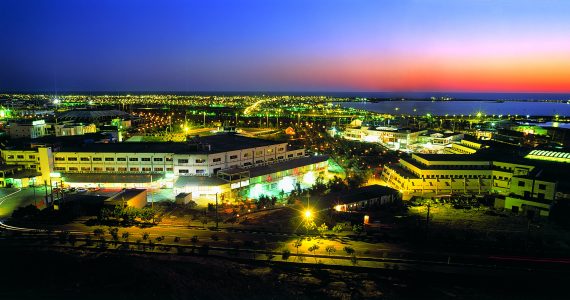
Chabahar Port: Why it’s important for India
Disclaimer: The views and opinions expressed in this article are those of the author and do not necessarily reflect the opinion of IFAIR e.V. or its members.
Chabahar, which in Persian means four springs, refers to the prevalence of springtime throughout the four seasons of the year. Such a beautiful place is located in the southeastern part of Iran on the Gulf of Oman. It is actually the capital of Chabahar county in the Sistan and Baluchistan province of Iran. Chabahar city is also home to Iran’s only deep-seaport with direct access to the ocean. It lies on the Gulf of Oman and is made up of two distinct ports, namely Shahid Kalantari and Shahid Beheshti.
At present India is developing this Chabahar Port of Iran. India was first offered to develop this port by Iran in the year 2003 during the visit of President Mohammad Khatami. India did take up this proposal but for around 12 years since then no major decision was taken for developing this port. This was due to international sanctions on Iran. It was only in the second half of 2014, after the start of a new government in Delhi, that some efforts were made for the development of this port. India’s NDA-led government approved an initial investment of USD 85.21 million for developing the port.
In December 2018, India took over the operations of the Shahid Behesti Port in Chabahar which has constituted the first time that India takes control of a port in foreign shores. India Ports Global Limited has been granted a lease of 18 months and later a period of ten years to operate this port.
The Chabahar Port has great importance to India for three main reasons:
Gateway to Central Asia and beyond
Before independence, India had direct access to Central Asia through Afghanistan and Tajikistan. But after independence and the birth of a new nation, Pakistan came in the way of creating a direct connection with Central Asia. Now in order to connect with Central Asia, India would have to do so via the land of Pakistan. But this has not been possible due to the strained relations between India and Pakistan, which have until now waged four wars.
Hence India has for long been trying to look at an alternative route to Central Asia. This was partly solved in the form of the International North South Transport Corridor (INSTC) which is a water/land/rail route to Central Asia, Russia and Europe via the Arabian Sea, Iran and the Caspian Sea bypassing Pakistan. India’s interest in connecting with Central Asia circumventing Pakistan got further impetus when it was given charge of developing the Chabahar Port. From Chabahar, India can connect with the border town of Zaranj in Afghanistan and then, through the Zaranj-Delram highway constructed by India, it can connect further north to Central Asia and beyond. So besides the INSTC, the Chabahar Port can help India in getting access to Central Asia and Europe.
Trading with Afghanistan
The INSTC allowed India to trade with the outside world via Iran, but India could not do so with Afghanistan in spite of being a very close neighbor. This was because Afghanistan was not a part of this INSTC project causing a major disadvantage to India.
In May 2016, a trilateral agreement was signed between India, Iran and Afghanistan for developing a transport and trade passageway between the three countries via the Chabahar Port and bypassing Pakistan. This has been of great advantage to India in getting a direct connection with Afghanistan. In fact, trading has already started between Afghanistan and India through this route. In October 2017, India shipped the first consignment of wheat to Afghanistan through this route and in February 2019, the first batch of exports (dry fruits, textiles, carpets and mineral products) was shipped to India by Afghanistan. Now, India can carry on its commercial activities with the Central Asian countries, Russia as well as Europe through this newly developed transit corridor leading to major commercial as well as financial profits for India. Furthermore, trading through the Chabahar Port takes less time saving money and energy for India.
Strategic Importance
The Chabahar Port is of great strategic importance due to its location in the Gulf of Oman and at the entrance of the Strait of Hormuz and enables Iran to have direct entree to the Indian Ocean. The Chabahar Port is also quite near the Gwadar Port of Pakistan being developed by China. Thus, by getting involved in developing the Chabahar Port, India will have presence in a strategically important region of the world. It can also closely monitor Chinese developments in the Gwadar Port.
In the aftermath of the escalation of US-Iran tension and attacks on oil tankers in the Strait of Hormuz, the Indian Navy has started escorting Indian crude oil carriers transiting through this Strait. Therefore, it is imperative for India to further strengthen its maritime power in this region for tackling any kind of future conflict and threats arising here.
Challenges
Although India’s development of the Chabahar Port until now has been exempted from US sanctions, the possibility of its withdrawal in the near future can be a major hindrance for India. The likelihood of Afghan Taliban rising to power and their recognition by major powers like Russia, the US and the EU may give Pakistan more leverage in the region causing a major disadvantage for India.
Despite these shortcomings, India should move ahead to fully develop this port at a fast pace and try to build a smooth transit route to Afghanistan and beyond. This is very essential for the fulfillment of India’s trading and commercial needs as well as for strategic purposes. Any obstacles in this project can be solved by diplomacy and dialogues between the countries involved.
In fact, the development of this port and a transit route to Central Asia, Russia and Europe via Iran and Afghanistan is a major benefit for all the stakeholders involved and hence a win-win situation for all. For both Iran and India, this port will reduce dependency on the Suez Canal and reduce transportation time. For landlocked Afghanistan it will be a gateway to the outside world by getting direct access to waterways for transportation and trading.
References:
https://www.rferl.org/a/india-iran-afghanistan/29674982.html
https://thediplomat.com/2019/01/india-doubles-down-on-chabahar-gambit/
https://thediplomat.com/2019/02/a-first-afghan-shipment-heads-to-india-via-irans-chabahar-port/

Dr. Rashmi R Baruah
Ph.D in Central Eurasian Studies from the University of Mumbai, India
